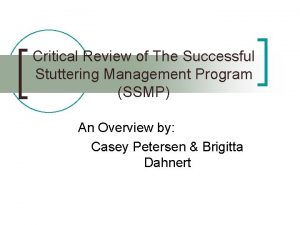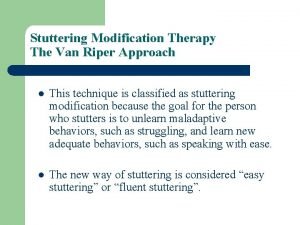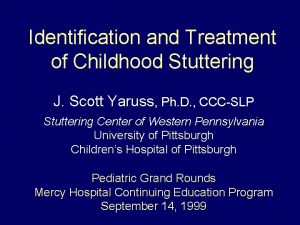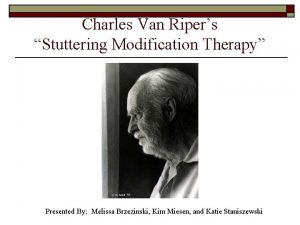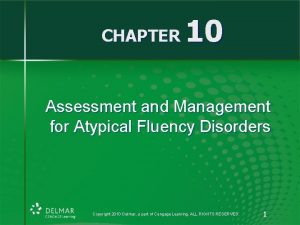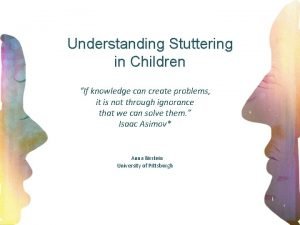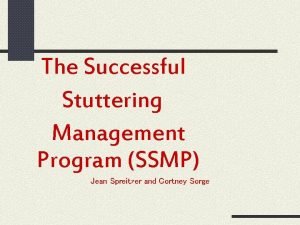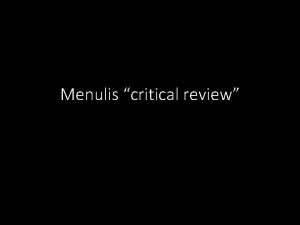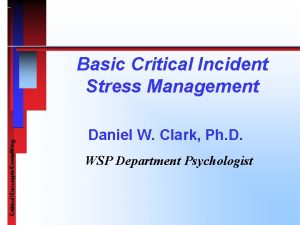Critical Review of The Successful Stuttering Management Program














- Slides: 14

Critical Review of The Successful Stuttering Management Program (SSMP) An Overview by: Casey Petersen & Brigitta Dahnert

Successful Stuttering Management Program (SSMP) n n Stuttering modification approach created by Dr. Dorvan Breitenfeldt and Delores Rustad Lorenz from Eastern Washington University (EWU). Incorporates: Traditional nonavoidance and stuttering modification techniques and fluencymodification procedures. (Breitenfeldt, 1990) “Focus of therapy is to teach the speaker to “handle” the once feared and out-of-control stuttering experience. ” (Breitenfeldt, 1990) This program has been used in workshops for the past 35 years at EWU.

Successful Stuttering Management Program (SSMP) Cont. n n n Designed for Adolescents and Adults It works best with groups but can be done individually. The suggested length of a session is 2 ½ to 3 hours for 17 treatment sessions, but can be broken up into smaller time increments. Each session is broken up into objectives, procedures, materials, and activities. The clients do many assignments with familiar people and even more with unfamiliar people. (Breitenfeldt et al, 1989)

SSMP Manual n “Taking therapy into the “real world” is the heart of the SSMP. ” (Breitenfeldt et al, 1989)

SSMP Theoretical Rationale n n A fundamental belief that stuttering is a “condition” that is chronic and the goal of therapy is for the person to “manage” the problem. Treats the whole person and not just the stuttering behavior Program is conducted to meet the individuals differences as much as possible Involves a group of people for emotional support and increased accountability (Breitenfeldt et al, 1989)

Principle Components to SSMP n n n Improvement of eye contact “Advertising” that they stutter Self awareness of speaking mechanism Teaching “handling procedures” to modify stuttering moments Developing “controlled normal speech”, emphasizing cognitive monitoring Negative practice of overt, easy stuttering (repetitions) (Breitenfeldt, 1990)

“Success” Defined and Measured n n Dr. Dorvan Breitenfeldt stated that, success is measured by questioners that evaluate how well the individual feels they can control their stuttering, and how they perceive themselves as a person who stutters. The goal is to get the individual to be more confident in their ability to communicate. (Breitenfeldt, 2004)

Generalization and Maintenance n n Two of the final sessions are designated for “Being your own clinician”, Session 15 and “Therapy Maintenance”, Session 16. Session 17 is “Graduation Day” including information for friends and family members (Breitenfeldt et al, 1989)

Data Regarding Program’s Success n Management program workshop in the United States of America (7 participants) and South Africa (8 participants) ¡ ¡ n The Attitude Scale probing subjects’ perceptions of what happens when they stutter and their feelings about stuttering found significant improvement between the pre and post treatment scores overall Secondary Behaviors were significantly reduced after treatment All the subjects noted that they would refer others to future workshops. Breitenfeldt et. al. (n. d. )

Strong Points n n Eclectic Program-manages and identifies problems, such as the human environment, feelings and reactions Open Communication- clinicians of this program have an open phone line to their past, present, and future clients (Breitenfeldt, 2004)

Weak Points n Requires a clinician not a technician ¡ ¡ n Not just a person who is trying to reach a goal but needs to relate to people, share with them, and be there for them for life. This is challenging on the clinician at times. All stuttering intervention has the challenge of maintaining success for life. (Breitenfeldt, 2004)

Recommendation n We like this program because: ¡ ¡ ¡ Price of manual is reasonable at $54. 95 Group based with individual accountability It teaches individuals to advertise themselves as a person who stutters rather than the stuttering introducing the individual to help decrease fear. Teaches the individual to be their own clinician Provides family support

Breitenfeldt http: //www. ssmpmanual. com/about. html n “The clinician will guide and execute this therapy program, but it is the responsibility of the stutterer to accept not only the fact that he is a stutterer, but also the responsibility for changing his way of communicating to one that is much more socially acceptable. ” (Breitenfeldt, D. H. , (n. d. ))

References n n n Breitenfeldt, D. , & Lorenz, D. (1989). Successful stuttering management program {ssmp} for adolescent and adult stutterers. 1 st ed. Cheney, WA: Eastern Washington University. Breitenfeldt, D. H. , & Lorenz, D. R. (1990). Successful stuttering management programs (ssmp) for adolescent and adult stutterers. ASHA, , 87 -88. Breitenfeldt, D. , & Girson, J. (n. d. ). 1 st world congress on fluency disorders, proceedings. Volume II ed. : International Fluency Association. Chapter 9, (429 -431). Breitenfeldt, D. H. (n. d. ). retrieved Nov. 23, 2004, from Successful Stuttering Management Program Web site: http: //www. ssmpmanual. com/. Breitenfeldt, Dorvan H. Telephone interview. 29 November 2004.
 Successful stuttering management program
Successful stuttering management program Critical semi critical and non critical instruments
Critical semi critical and non critical instruments Semi-critical
Semi-critical A key element to a successful training program is
A key element to a successful training program is Slidetodoc.com
Slidetodoc.com Charles van riper stuttering modification therapy
Charles van riper stuttering modification therapy Todays final jeopardy answer
Todays final jeopardy answer What causes stuttering
What causes stuttering Bucket analogy stuttering
Bucket analogy stuttering Gilcu
Gilcu Tachyphemia example
Tachyphemia example Midvas therapy
Midvas therapy Neurogenic stuttering
Neurogenic stuttering Iceberg analogy stuttering
Iceberg analogy stuttering Dsm 5 stuttering
Dsm 5 stuttering
